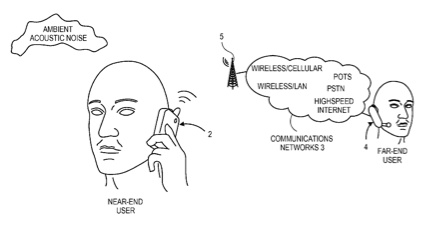An Apple patent (number 20110299695) for active noise cancellation decisions in a portable audio device show that the company continues to look at ways to improve the sound quality in its iOS and portable devices.
Per the patent, active noise cancellation (ANC) circuitry is coupled to the input of an earpiece speaker in a portable audio device, to control the ambient acoustic noise outside of the device and that may be heard by a user of the device. A microphone is to pickup sound emitted from the earpiece speaker, as well as the ambient acoustic noise. Control circuitry deactivates the ANC in response to determining that an estimate of how much sound emitted from the earpiece speaker has been corrupted by noise indicates insufficient corruption by noise.
In another embodiment, the ANC decision is in response to determining that an estimate of the ambient noise level is greater than a threshold level of an audio artifact that could be induced by the ANC. Guy C. Nicholson is the inventor.
Here's Apple's background on the invention: "Mobile phones enable their users to conduct conversations in many different acoustic environments, some of which are relatively quiet while others are quite noisy. The user may be in a particularly hostile acoustic environment, that is, with high background or ambient noise levels, such as on a busy street or near an airport or train station. To improve intelligibility of the far-end user's speech to the near-end user who is in a hostile acoustic environment (i.e., an environment in which the ambient acoustic noise or unwanted sound surrounding the mobile phone is particularly high), an audio signal processing technique known as active noise cancellation (ANC) can be implemented in the mobile phone.
"With ANC, the background sound that is heard by the near-end user through the ear that is pressed against or that is carrying an earpiece speaker, is reduced by producing an anti-noise signal designed to cancel the background sound, and driving the earpiece speaker with this anti-noise signal. Such ambient noise reduction systems may be based on either one of two different principles, namely the 'feedback' method, and the 'feed-forward' method.
"n the feedback method, a small microphone is placed inside a cavity that is formed between the user's ear and the inside of an earphone shell. This microphone is used to pickup the background sound that has leaked into that cavity. An output signal from the microphone is coupled back to the earpiece speaker via a negative feedback loop that may include analog amplifiers and digital filters. This forms a servo system in which the earpiece speaker is driven so as to attempt to create a null sound pressure level at the pickup microphone.
"In contrast, with the feed-forward method, the pickup microphone is placed on the exterior of the earpiece shell in order to directly detect the ambient noise. The detected signal is again amplified and may be inverted and otherwise filtered using analog and digital signal processing components, and then fed to the earpiece speaker. This is designed to create a combined acoustic output that contains not just the primary audio content signal (in this case the downlink speech of the far-end user) but also a noise reduction signal component.
"The latter is designed to essentially cancel the incoming ambient acoustic noise, at the outlet of the earpiece speaker. Both of these ANC techniques are intended to create an easy listening experience for the user of a portable audio device who is in a hostile acoustic noise environment."
-- Dennis Sellers













